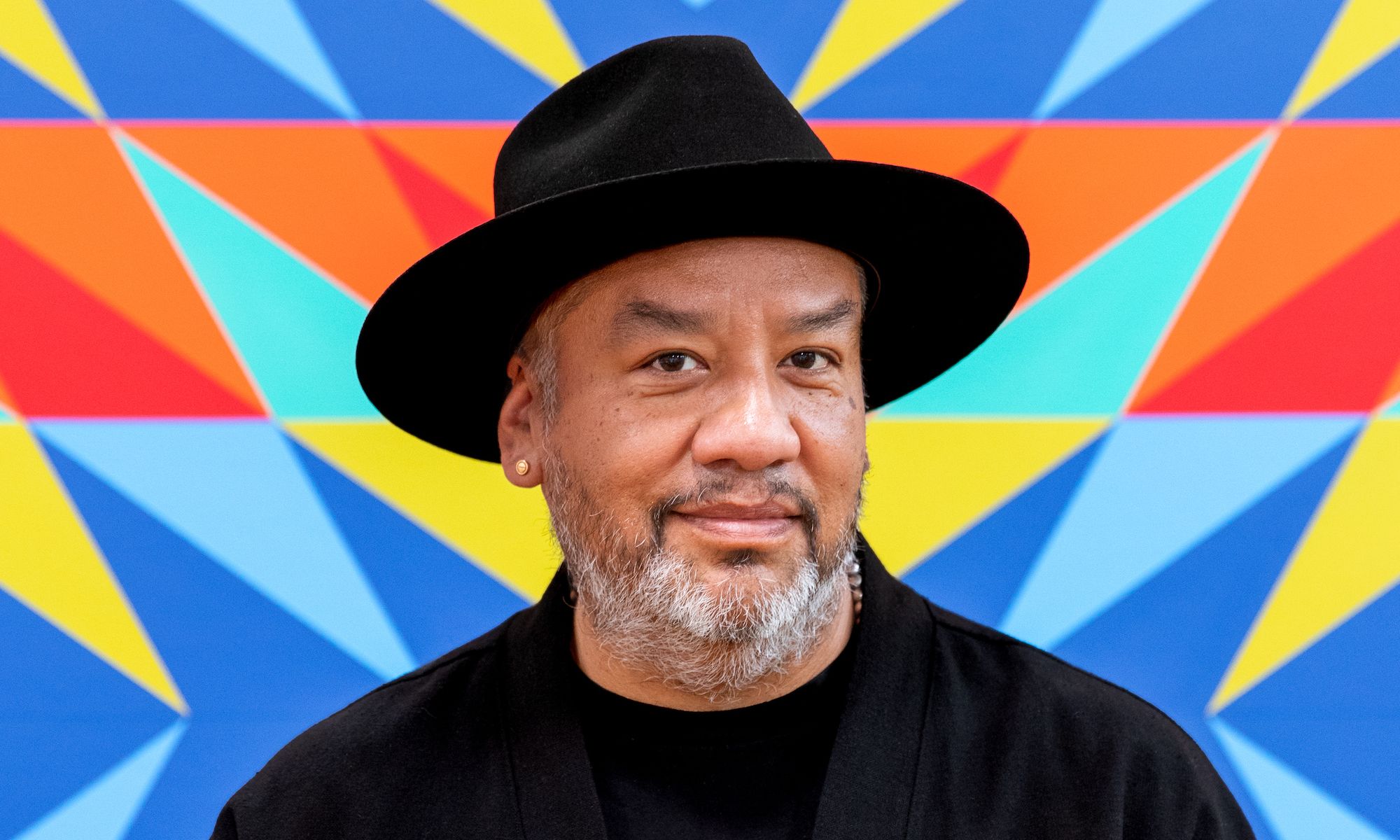Jeffrey Gibson Brian Barlow
Jeffrey Gibson, a Colorado-born, New York-based artist who is a member of the Mississippi Band of Choctaw Indians and of Cherokee descent, will represent the United States at the next Venice Biennale (20 April-24 November 2024, becoming the first Indigenous artist to have a solo exhibition in the US Pavilion.
Gibson’s work mixes many traditions, combining techniques from Indigenous beading, weaving, metalwork and more with the formal language of hard-edged abstract painting, Pop Art sculpture and more, spanning media such as sculpture, painting, installation and performance. He is perhaps best known for suspended punching-bag sculptures that incorporate elaborate threads, fringes, jingles and beaded text, as well as large-scale paintings that feature stylised text rendered in boldly colourful patterns.
Jeffrey Gibson, PEOPLE LIKE US, 2019. Photo Courtesy of Sikkema Jenkins & Co.
For his exhibition in Venice, Gibson will create interventions inside the US Pavilion, on its exterior and in its courtyard, incorporating elements of performance and multimedia installations in addition to static works. Through partnerships with the Institute of American Indian Arts in Santa Fe and Bard College in New York State, the pavilion will also incorporate educational programming. This will include bringing students from the Institute of American Indian Arts to Venice in the summer of 2024 and an educational convening in autumn.
“The last 15 years of my career have been about turning inward and trying to make something I really wanted to see in the world,” Gibson, reflecting on his selection for the Biennale, told The New York Times. “Now I want to expand the way people think about Indigeneity.”
Jeffrey Gibson, The Body Electric, 2022. Installation view at SITE Sante Fe. Photo by Shayla Blatchford. Photo Courtesy of SITE Sante Fe.
Gibson’s presentation in Venice is being co-commissioned by Kathleen Ash-Milby (Navajo Nation), the Portland Art Museum’s curator of Native American art; Louis Grachos, the executive director of Site Santa Fe; and independent curator Abigail Winograd.
“Throughout his career, Jeffrey has challenged us to look at the world differently through his innovative and vibrant work,” Ash-Milby—who is also the first Native American co-curator in the 129-year history of the US Pavilion in Venice—said in a statement. “His inclusive and collaborative approach is a powerful commentary on the influence and persistence of Native American cultures within the United States and globally, making him the ideal representative for the United States at this moment.”
Jeffrey Gibson, Because Once You Enter My House It Becomes Our House, 2020, at Socrates Sculpture Park in Queens, New York. Photo by: Brian Barlow.
Winograd, who is co-curating the pavilion with Ash-Milby, added in a statement: ““I have long believed in the ability of Jeffrey's work to be a force for positive change and to create the possibility of a radically inclusive future. It is my hope that as a global audience experiences his work through the Biennale, they will also find it to be a source of joy and healing, something sorely needed in a world driven by conflict and crisis.”
As is customary, in addition to the Portland Museum of Art in Oregon and Site Santa Fe in New Mexico, the US Pavilion is being organised in cooperation with the US State Department.
Jeffrey Gibson, The Spirits Are Laughing, 2022. Courtesy of Jeffrey Gibson
Gibson’s work has been exhibited widely throughout the US over the past decade, including major solo exhibitions at the Institute of Contemporary Art, Boston in 2013 and the Ruth and Elmer Wellin Museum of Art in 2018 (which subsequently toured to the Blanton Museum of Art in Texas) and a presentation at the 2016 Site Santa Fe Biennial (which also then toured). His work figured prominently in the 2017 Desert X Biennial and the 2019 Whitney Biennial. Last May, the National Gallery of Art acquired a major work by Gibson; he is also represented in the collections of many major US museums including the Buffalo AKG Art Museum, Crystal Bridges Museum of American Art, Denver Art Museum, SFMoMA, Seattle Art Museum and many others.
The US was most recently represented in Venice by Simone Leigh, who also transformed the exterior of the country’s 1930 Palladian pavilion in the Giardini. Prior to Leigh, the US was represented by Martin Puryear in 2019 and Mark Bradford in 2017.

